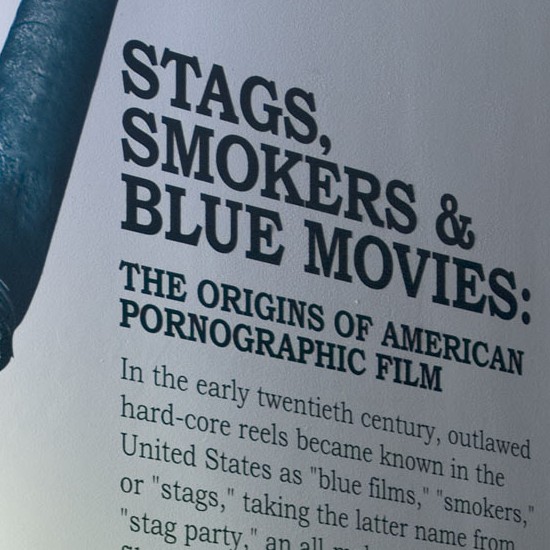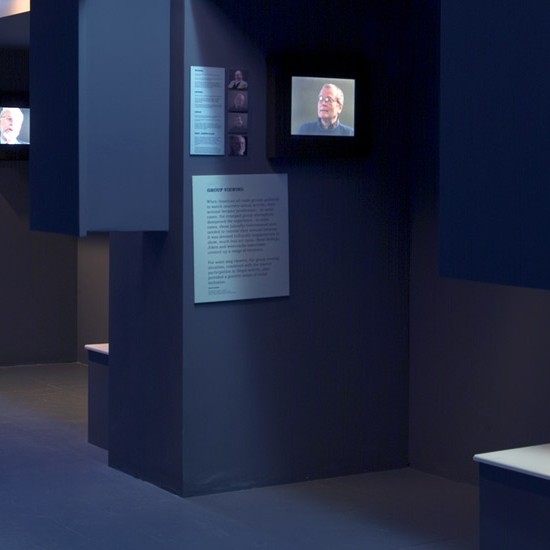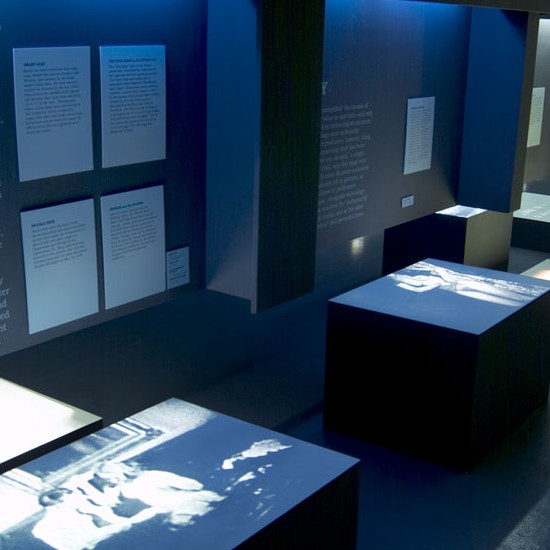Patrons witnessed the underground evolution of the sex-film industry as the Museum of Sex recaptured the clandestine celluloid of the twentieth century in Stags, Smokers, and Blue Movies: The Origins of American Pornographic Film.
Hard-core pornographic films, each the 10-12 minute length of a single reel of 35 mm celluloid stock, began to appear around 1907, a few years after the first soft-core “nudies” that depicted solo women in states of undress. They were shot independently in Hungary, Spain, Italy, France, Germany, Austria, Russia, Argentina, North Africa, and the United States, usually by semi-professionals on the margins of emerging film industries. Most early examples have been lost. Some were shot for local use in bordellos; some used incompatible technical formats that were abandoned before the reels could be copied; others disappeared because they were captured on highly perishable nitrate film stock; still others, especially those from Austria and Germany, would be destroyed during World War II. Only a few survive from the years 1910-1919; two are from the United States.
In the 1920s, France, Germany, and the United States produced about two dozen each. From 1930 to 1965, the United States produced more stags (usually on 16mm) than any other country, save for brief periods in the early 1950s and 1960s, when Britain and Denmark respectively took the lead in production. Government-sanctioned destruction, haphazard loss, re-editing, and retitling render an exact count difficult, but it is estimated that approximately 1700 survive from around the world.
In the United States, these outlaw films became known as “stags,” taking their name from “stag party,” a social gathering of males where films were exhibited. The clandestine, ritual characteristics of their exhibition defined their style and content until the 1960s, when newer, more public and then more private technologies (the 8mm loop, the feature, the videocassette, and the DVD) displaced the stag.
In the late 1960s and early 1970s, waning censorship coupled with newer technologies made it possible for producers to cater to the wide range of specific tastes of global consumers. Today the United States alone produces more than 10,000 hard-core pornographic videocassettes and DVDs annually.
CURATORIAL
Joseph Slade, Ph.D.
Curator
Joseph Slade is professor and Associate Director for Graduate Studies at the School of Telecommunications at Ohio University, Zanesville. He is author of Pornography and Sexual Representation: A Reference Guide in 3 volumes (2001); which was designated “Best Reference Work of 2001” by Library Journal. He has served as film consultant to the Kinsey Institute of Sex, Gender, and Reproduction.
Sarah Forbes
Curator, Research
Sarah Jacobs received a BA in Anthropology from Connecticut College, with an additional certificate from the Center for International Studies in the Liberal Arts for her honors thesis regarding beauty as a form of empowerment in Venezuela. She completed an MA in Anthropology at the New School University in New York. In mid 2006, Sarah became the curator of the Museum of Sex.
Ryan Chaney
Research
Jennifer Lyon Bell
Co-Curator
Jennifer Lyon Bell is an American writer and filmmaker currently based in Amsterdam. She lectures extensively on cognitive film theory and its relevance in exploring how erotic cinematic images evoke emotional and physical sensations. As the owner of Blue Artichoke Films, she writes and directs erotic films for women. Bell received a B.S. in Psychology from Harvard University and an M.A. in Film Studies from the University of Amsterdam.
DESIGN
Joshua Berger
Graphic Design
Joshua Berger is a founder and principal of Plazm, an award-winning design firm, type foundry, and publisher of Plazm magazine. Berger has been recognized by design publications and award shows including the AIGA Annual Show, the Art Directors Club, and an honorary exhibition at ZGRAF 9. His books received Gold Medals at the Leipzig Bookfair for his collaboration with John C. Jay on Soul of the Game (Workman Publishing, 1997) and the Portland Design Festival for XXX: The Power of Sex in Contemporary Design (Rockport, 2003). His most recent projects include the art direction and design of Marion Jones: Life in the Fast Lane (Warner Books, 2004), co-curation and design of the forthcoming book Queer Graphics: the Untold History, and the development and overseeing of Anti-war.us, a web project that collects anti-war graphics from the international design community for distribution to activists around the world.
Casson Mann
Exhibition Design
Casson Mann is an innovative design consultancy that is quietly revolutionizing the formerly fusty world of museums and galleries. Add to this its groundbreaking work for a top lawyers’ chambers, a television media consultancy and its work abroad for the British Council and it is easy to see why Casson Mann is swiftly becoming one of the most talked about interior and exhibition design agencies in the country.
Dinah Casson and Roger Mann formed the practice in 1984 and since then Casson Mann has worked on a wide variety of projects including offices, old building refurbishments, exhibitions and theatre design. The company has worked with the broadest spectrum of professionals at all levels in the design process, from inventors and engineers to film-makers, historians, graphic designers, lighting designers, writers, musicians and architects.
Entropy8Zuper!
Interactive Installation
Entropy8Zuper! is a web design studio and interactive arts collective. They make emotionally engaging multimedia presentations that range from the ultra corporate to the hyper personal.
Charles Gansa
Audio Production
For the audio portion of the exhibition, Gansa hosted a stag party revival in Greenpoint featuring 23 young American men (double-tracked to sound like 46), old films, peel top beer cans and authentic macho tension. He composes for film and television and lives in Brooklyn with his family.


